Animal Facts
Bird Breeding Genetics: How to Achieve Specific Colors and Patterns
Master the intricacies of bird breeding genetics to unlock stunning colors and patterns—discover the secrets that could transform your breeding success.

To achieve specific colors and patterns in bird breeding, you'll need to understand the genetic principles at play. Start by studying the color alleles on the Z chromosome, which shape feather coloration. Dominant alleles can mask recessive traits, so choose your breeding pairs wisely. For example, pairing yellow cocks with blue check hens can yield desirable traits. Keep detailed records of offspring to refine your strategy over generations. Engaging with the community can also provide valuable insights and tips. There's a lot more to explore in mastering the art of bird breeding and achieving your ideal results.
Key Takeaways
- Understand the inheritance patterns of color alleles, focusing on the Z chromosome for predicting feather coloration in male birds.
- Utilize dominant and recessive alleles strategically to achieve desired color traits in offspring through informed breeding pair selections.
- Monitor offspring closely to identify base colors and traits, adjusting breeding strategies as needed for future generations.
- Employ techniques like line-breeding and backcrossing to refine specific color and pattern traits over time.
- Engage with breeding communities, such as forums, for insights and shared experiences on achieving specific color outcomes.
Understanding Avian Coloration
Have you ever wondered why birds display such a dazzling array of colors? The secret lies in the pigments that create their stunning feather color. Melanin is one of the key players, producing shades of brown, black, and reddish-brown. This pigment is essential for many species, especially pigeons, where the Tyrp1 gene greatly influences melanin production. Different alleles of this gene lead to variations in feather color, like blue, brown, or ash-red, depending on how the TYRP1 protein functions.
Additionally, understanding the genetic factors that influence coloration can be akin to how geothermal energy harnesses the earth's internal processes for sustainable solutions. But melanin isn't the only factor at play. Birds also rely on carotenoids from their diet to achieve vibrant reds, yellows, and oranges.
Beyond pigments, structural colors arise from the intricate microstructures in feathers, which interact with light to create iridescent effects. This can change based on how you view the bird, adding an extra layer of complexity to their coloration.
Additionally, birds possess tetrachromatic vision, allowing them to see colors beyond human perception. Understanding these aspects of avian coloration is essential for bird breeders aiming to achieve specific colors and patterns, enhancing the beauty of their feathered friends.
Genetic Mechanisms of Color
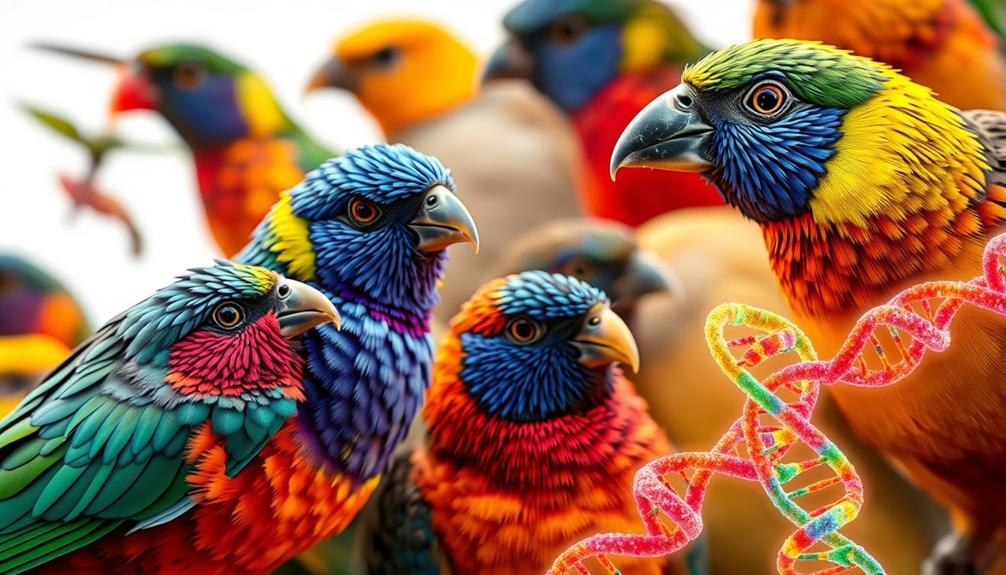
When you explore the genetic mechanisms of color in birds, you'll find that the color gene alleles play an essential role.
Understanding how these alleles interact through inheritance patterns reveals the dominance and recessiveness that dictate feather coloration.
Additionally, the concept of astrological compatibility can be likened to the unique combinations of genes that contribute to a bird's visual appeal.
This knowledge helps you appreciate the complexity behind the stunning hues you see in avian species.
Color Gene Alleles
In the fascinating world of bird breeding genetics, color gene alleles play a essential role in determining feather coloration. The major color locus is located on the Z chromosome, which means males, with their two Z chromosomes, express colors based on the more dominant allele they carry.
For instance, in pigeons, the primary alleles are blue, brown, and ash-red, each affecting melanin production differently. Additionally, understanding the concept of diversification of retirement portfolio can be beneficial for breeders looking to invest in their passion.
The blue allele allows for normal TYRP1 protein production, resulting in black melanin. In contrast, the brown allele leads to no TYRP1 production, allowing brown melanin to dominate. The ash-red allele disrupts melanin production entirely, altering the feather color appreciably.
Females inherit their color allele exclusively from their fathers, which means the males' color traits are essential for determining the color of the female offspring. Understanding these alleles helps you predict and achieve specific color outcomes in your breeding program.
Inheritance Patterns Explained
Understanding color gene alleles sets the stage for exploring inheritance patterns in bird breeding. The major color locus for feather color resides on the Z chromosome, creating sex-linked inheritance patterns. Males have two copies of the color gene, while females have only one. This difference greatly impacts how color traits are passed on.
In the context of breeding, knowing about vegan alternatives can help in selecting appropriate diets for birds that may affect their health and feather quality.
In this system, female pigeons inherit their color allele exclusively from their fathers. In contrast, males can pass one color allele to both sons and daughters. You'll find three alleles for the color gene: blue, brown, and ash-red. Males express colors based on the most dominant allele they possess, which is critical for understanding inheritance patterns.
The Tyrp1 gene further complicates things, as it's responsible for variations in feather color. Different alleles produce distinct TYRP1 proteins, influencing melanin production and assembly.
For breeding purposes, knowing the dominance hierarchy among alleles is essential. For example, the blue allele produces normal TYRP1, while the brown allele leads to brown melanin dominance. By grasping these inheritance patterns, you can effectively predict offspring color outcomes in your breeding projects.
Dominance and Recessiveness
Dominance and recessiveness play an essential role in determining bird coloration, as the interplay of alleles reveals which traits will be expressed in the phenotype.
In bird genetics, dominant alleles can mask the effects of recessive ones, shaping the visible traits you observe. Understanding this hierarchy is key to effective breeding strategies.
Additionally, studies suggest that certain traits may enhance overall allure, much like how astrology correlates with attractiveness, as seen in astrology and attractiveness.
Here are three important points to remember:
- Dominance Hierarchy: In pigeons, for instance, the T-check pattern is the most dominant, followed by check, bar, and finally, barless, which is recessive.
- Phenotypic Expression: Less dominant alleles can still show their influence, contributing to features like flecks in feathers, indicating that dominance doesn't always equate to overall superiority.
- Multiple Alleles: Coloration is often governed by multiple alleles at a single locus, leading to a variety of possible phenotypes in your offspring.
Sex-Linked Color Inheritance

When you breed pigeons, understanding how feather color is inherited can really impact your results.
Male pigeons showcase their feather color based on the dominant alleles they inherit, while females get their color genes solely from their fathers. This difference in inheritance patterns can lead to distinct color variations in your breeding outcomes.
Additionally, just as with cats and their emotional attachment, the genetic traits in birds can create unique patterns of behavior and visual appeal that enhance the overall breeding experience.
Male Feather Color Expression
Here is the revised content with the long paragraphs split:
—
Exploring the intricacies of male feather color expression in pigeons reveals the fascinating dynamics of sex-linked color inheritance.
Male pigeons carry two Z chromosomes, allowing them to express feather color based on the dominant allele of the color gene located on the Z chromosome. This unique genetic structure leads to distinct patterns in color inheritance.
Understanding the impact of genetic factors on traits can provide insight into breeding success, similar to how narcissistic traits can stem from genetic influences.
Here are three key points to understand:
- Dominance Hierarchy: The color gene has three alleles—blue, brown, and ash-red—with blue being the most dominant, followed by brown and then ash-red.
- Inheritance Patterns: Males inherit and can express both color alleles, while females solely inherit their single color allele from their fathers, which determines their feather color.
- Color Expression: In this sex-linked system, males can pass one color allele to both sons and daughters, leading to a range of color expressions among their offspring.
Understanding male feather color expression not only enhances your breeding strategies but also deepens your appreciation for the complex genetics that shape these beautiful birds.
Embracing these principles will help you achieve the specific colors and patterns you desire in your breeding endeavors.
Female Color Gene Inheritance
In the domain of pigeon breeding, understanding female color gene inheritance is vital for predicting feather color outcomes. Female pigeons inherit their color traits solely from their fathers, as they possess one Z and one W chromosome. The color gene resides on the Z chromosome, meaning that the female pigeon's feather color depends directly on the male's genotype.
Here's a quick overview of the inheritance patterns:
| Parent Male | Color Allele | Female Offspring Color |
|---|---|---|
| Black | B | Black |
| Blue | b | Blue |
| Red | R | Red |
Since females only carry one copy of the color gene, they can't express color traits unless their father possesses the corresponding allele. This sex-linked inheritance results in distinct color expressions, with males showcasing a wider variety due to having two alleles. Fundamentally, when you're selecting your breeding pairs, remember that the color alleles of the males are significant in determining the visual outcomes in your female pigeons.
Alleles and Color Expression
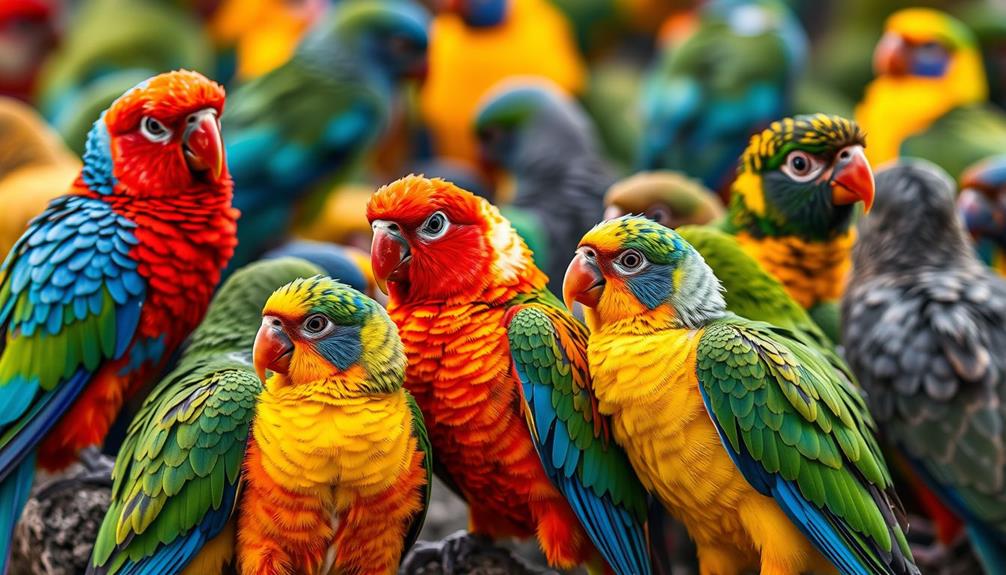
Birds exhibit a fascinating array of colors and patterns, largely determined by the alleles they inherit. Understanding how these alleles influence color expression is vital for breeders like you. Each bird's genotype consists of two alleles, one from each parent, and the phenotype—what you see—reflects the dominant allele's expression.
In addition to genetic factors, knowledge of plant properties and their medicinal uses can enhance your understanding of breeding practices, as both fields rely on the principles of inheritance and variation in nature. For those interested in natural remedies, essential knowledge for herbalism can provide insights into how to approach selective practices.
The hierarchy of dominance among the alleles influencing wing patterns is as follows:
- T-check (most dominant)
- Check
- Bar
- Barless (recessive)
This means that if a bird has a T-check allele, it will display that pattern, regardless of the other allele it carries. However, even recessive alleles, like barless, can influence color if paired with another recessive allele.
Genetic linkage further complicates inheritance patterns, as the pattern gene is often inherited alongside the spread gene. By grasping the dominance and linkage of these alleles, you can predict potential offspring traits more accurately, guiding your selective breeding efforts toward achieving desired colors and patterns.
Melanin Production and Types

Melanin production plays an essential role in determining the vibrant colors and patterns you see in avian species. This process is primarily driven by the amino acid tyrosine, which serves as a precursor for synthesizing distinct melanin pigments.
There are two main types of melanin: eumelanin, which produces black and brown colors, and pheomelanin, which results in yellow and reddish pigments. The balance and proportions of these two types dictate the overall feather color you observe in birds. Additionally, factors like altitude acclimatization can influence the health and liveliness of breeding birds, potentially affecting their coloration as well.
The Tyrp1 gene is essential for melanin assembly, and different alleles of this gene can considerably affect the production and quality of the TYRP1 protein. This, in turn, influences the feather coloration you're aiming for in your breeding projects.
By understanding the various alleles and their effects on melanin production, you can make informed decisions to achieve specific colors and patterns in your birds.
Keep in mind that variations in melanin production mechanisms not only contribute to avian coloration but also have implications for coloration in other animals, such as dogs and cats, showcasing the broader importance of these genetic factors.
Structural Colors in Birds
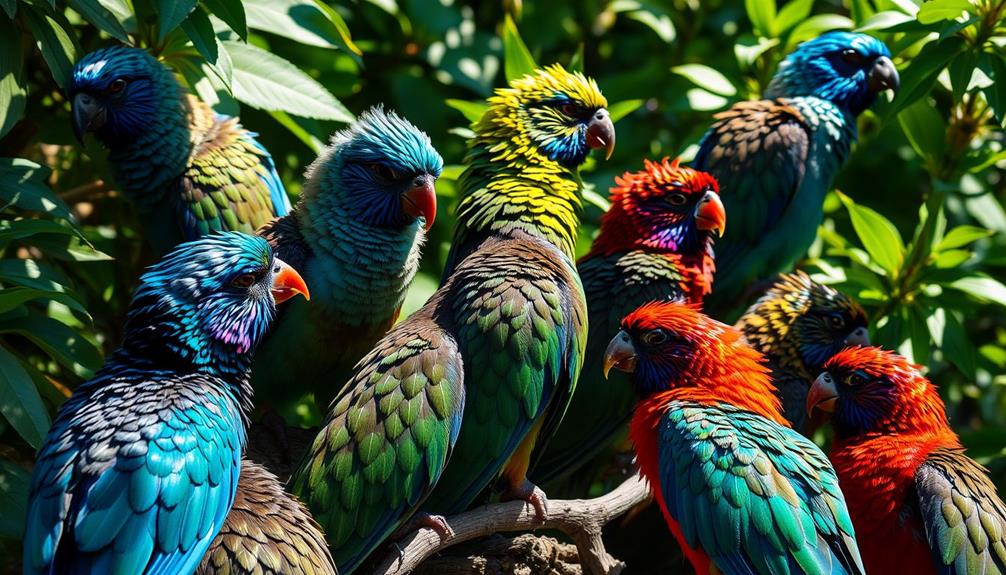
How do birds achieve the stunning hues and patterns that captivate our eyes? The secret lies in structural colors, which result from intricate nanoscale structures in their feathers. These structures interact with light, producing both iridescent and non-iridescent appearances.
Curiously, just as essential oils can enhance overall well-being through their unique properties, the pigments and microscopic structures in feathers play an essential role in avian health and communication, particularly in their mating rituals and territory displays essential oils for wellness.
Here's how they work:
- Iridescent Colors: These colors shift based on your viewing angle, thanks to coherent light scattering. This means the same feather can appear differently depending on how the light hits it.
- Non-Iridescent Colors: Unlike their iridescent counterparts, these colors stay consistent no matter the angle, creating a reliable visual cue.
- Micropatterning: The microscopic patterns in feathers contribute to the diversity of structural colors, playing an essential role in avian communication and signaling.
Despite the beauty of these colors, the genetic basis behind their production remains largely unexplored.
This complexity poses challenges for researchers trying to link genetics with the morphological variations seen in bird species. Understanding these mechanisms is fundamental for advancing studies on avian coloration and its evolutionary implications, paving the way for future discoveries in bird breeding genetics.
Breeding Techniques for Color
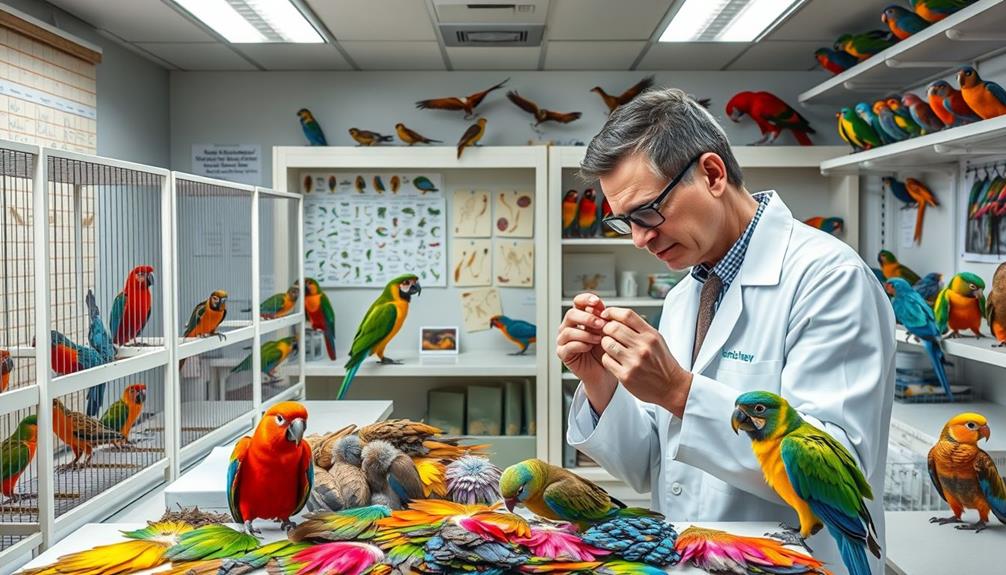
Revealing the vibrant colors in bird breeding requires a solid grasp of genetic principles and strategic pairing techniques. Understanding the dominance hierarchy of alleles is essential. For instance, T-check is the most dominant allele for wing patterns, allowing you to predict offspring traits effectively.
To achieve specific colors, consider the following pairings:
| Pairing Type | Expected Offspring Color |
|---|---|
| Yellow Cock x Blue Check Hen | Dilute Sons |
| Blue Check Hen x Yellow Cock | Varying Color Outcomes |
| Avoiding Recessive Red Genes | Achieve Yellow Bars |
| Monitoring Offspring | Identify Base Colors |
When breeding, always remember that hens contribute only one color allele to their sons. Avoid recessive red genes if you want to achieve specific outcomes. Engaging with community resources, like the Pigeon-Talk forum, can also provide valuable insights and shared experiences to enhance your breeding strategies. By applying these techniques, you'll be well on your way to revealing the stunning colors and patterns you desire in your birds.
Selecting for Desired Traits

When you're selecting for desired traits in bird breeding, grasping the dominance hierarchy of alleles is crucial. Dominant alleles will dictate the phenotype expressed in your offspring, so understanding these relationships can help you achieve your goals.
Here are three key strategies to reflect upon:
- Pairing Based on Traits: Choose strategic pairings, like yellow cocks with blue check hens, to produce specific color outcomes, such as dilute sons.
- Analyze Genotypes: Always analyze the genotypes of both parents. The genetic linkage between traits can complicate predictions, so knowing the alleles in play is essential for anticipating offspring traits.
- Observe Offspring: Pay close attention during growth. Careful observation of the color and pattern traits in your offspring can provide invaluable insights for future breeding decisions.
Utilizing resources like Pigeon-Talk forums can also enhance your understanding of genetic traits and successful breeding strategies. Engaging with the community allows you to learn from shared experiences and expert insights, helping you refine your approach to selecting for desired traits in your bird breeding endeavors.
Long-Term Breeding Strategies

Successful bird breeding requires a well-thought-out long-term strategy that aligns with your vision for the desired traits. Start by establishing a clear vision, focusing on consistent colors and patterns to guide your efforts.
Your breeding plan should incorporate techniques like line-breeding and recurrent backcrossing. These methods help refine specific traits while reducing the risk of recessive traits emerging.
Keeping detailed records in a breeding diary is essential. Document your successes, failures, and genetic progress, as this information will inform future breeding decisions.
Don't underestimate the value of collaboration; working with other breeders can enhance genetic diversity and introduce new traits. Swapping unrelated birds and pooling resources can lead to exciting possibilities.
Flexibility is key. Be ready to adjust your breeding strategies based on the outcomes of previous generations.
This adaptability will allow you to continuously improve and get closer to achieving your targeted color and pattern goals. By following a structured breeding plan and remaining open to change, you'll steadily progress toward creating the birds you envision.
Frequently Asked Questions
What Is the Genetic Color of Birds?
The genetic color of birds varies widely, influenced by different alleles. You'll find colors ranging from blue to brown, with inheritance patterns affecting how males and females express these vibrant hues in their feathers.
What Is the Genetic Basis for Red Coloration in Birds?
The genetic basis for red coloration in birds involves specific genes that regulate carotenoid absorption. Variations in these genes affect the intensity of red hues, influencing mate selection and signaling overall health and nutritional status.
What Ways Can a White Phenotype in Pigeons Be Created?
If you're dreaming of snowy feathers, you can create a white phenotype in pigeons by carefully pairing birds with hidden recessive alleles. This way, you may surprise yourself with delightful white offspring in your flock!
What Is the Number of Genes That Influence the Wing Pattern Trait?
The wing pattern trait is influenced by a single gene with four alleles. By understanding this gene's dominance hierarchy, you can predict which patterns will appear in offspring when breeding birds with different genotypes.
Conclusion
In the fascinating world of bird breeding, understanding genetics is key to achieving those stunning colors and patterns you desire. With careful selection and long-term strategies, you can bring your vision to life. Remember, "patience is a virtue." It might take time, but the joy of seeing your feathered friends flaunt their unique hues makes every effort worthwhile. So immerse yourself in the science, experiment with your techniques, and watch your avian dreams take flight!
Dana is our Lead Content Writer, bringing a wealth of knowledge and expertise to our team. With a background deeply rooted in animal studies and a profound love for all creatures, Dana is dedicated to crafting engaging and informative content that resonates with our audience. With Dana at the helm, you can trust that our content is accurate and engaging, catering to the diverse interests of animal enthusiasts everywhere.
Animal Facts
The Impact of Climate Change on Local Wildlife: What You Can Do to Help
Over 60% of local wildlife faces extinction due to climate change—discover simple actions you can take to protect these vulnerable species and their habitats.

Climate change is reshaping local wildlife, putting nearly 60% of species at risk of extinction. You can make a difference by planting native species, which support biodiversity and absorb CO2. Reducing waste by recycling helps lower your carbon footprint. Volunteering at local wildlife refuges aids habitat restoration, while engaging in citizen science contributes valuable insights to conservation efforts. Advocate for protective policies that empower your community's environmental initiatives. Every small action counts in this urgent fight against habitat loss. Discover even more impactful ways you can help local wildlife thrive amid these changes.
Key Takeaways
- Support local wildlife conservation efforts to protect habitats and promote biodiversity, which is essential for ecosystem health.
- Engage in community initiatives that restore natural habitats and raise awareness about the impacts of climate change on wildlife.
- Plant native species in your garden to enhance local ecosystems and provide food and shelter for wildlife.
- Participate in citizen science projects to contribute data on local wildlife populations and help inform conservation strategies.
- Advocate for sustainable practices and protective policies that mitigate climate change effects on wildlife and their habitats.
Importance of Wildlife Conservation
Wildlife conservation is essential not just for the survival of various species but also for the health of our planet. As you engage in wildlife conservation, you help protect not only endangered animals but also the ecosystems they inhabit.
These ecosystems play a significant role in regulating climate change, enhancing carbon sequestration, and maintaining biodiversity. Renewable energy sources, such as geothermal energy, are integral to reducing the carbon footprint, which helps mitigate climate change effects on wildlife.
Sadly, we've seen a shocking 69% decline in wildlife populations over the last 50 years, which underscores the urgent need for action.
By protecting wildlife, you contribute to the balance of greenhouse gases in the atmosphere, promoting healthier environments. Establishing protected areas is one effective climate adaptation strategy that safeguards threatened species, ensuring ecosystems remain resilient against the impacts of climate change.
Additionally, your support for wildlife conservation helps local communities thrive by promoting sustainable practices and preserving natural resources.
Impact of Climate Change on Wildlife

Climate change is putting many species at risk of extinction, with about 60% facing dire consequences if we don't act quickly.
As habitats shrink and conditions worsen, wildlife struggle to adapt, leading to challenges like increased mortality rates in vulnerable populations.
Dietary modifications can also play a role in wildlife health, as changes in food availability impact species survival.
You might be surprised to learn how these changes create a ripple effect that threatens our planet's biodiversity.
Species Extinction Risks
The threat of species extinction looms large as rising global temperatures and shifting ecosystems continue to disrupt the delicate balance of nature. Climate change poses a grave threat to biodiversity, with projections suggesting that up to 60% of global species could face extinction without immediate action.
The decline in wildlife populations has been staggering, with nearly 70% vanishing over the last 50 years, primarily driven by climate change and its impacts. Additionally, the impact of climate change on ecosystems can be compared to how Aboriginal art features distinctive styles that reflect the connection between culture and environment.
Rising temperatures create additional stressors, such as habitat loss and invasive species, that further exacerbate extinction risks. Many species struggle to adapt quickly enough to these changes, forcing them to migrate to new habitats. However, not all can make this shift, increasing their vulnerability to extinction.
For instance, while the Oceanic Whitetip Shark shows resilience, most wildlife isn't so fortunate.
You can contribute to conservation efforts that address these extinction risks. Supporting local wildlife organizations, advocating for sustainable practices, and reducing your carbon footprint can help protect vulnerable species.
Every action counts in the fight against climate change and its devastating effects on our planet's biodiversity. Together, we can work toward a more sustainable future for wildlife.
Habitat Loss Challenges
As species face increasing extinction risks, habitat loss emerges as a critical challenge exacerbated by climate change. Rising temperatures and changing weather patterns are forcing wildlife to migrate or confront extinction. An estimated 60% of global species could face extinction if we don't act urgently to address emissions and habitat degradation.
For instance, Africa's elephants are at risk of disappearing within 40 years due to habitat loss and poaching linked to climate-related changes. Additionally, the loss of biodiversity impacts food security and ecosystem health, making it essential to support sustainable agricultural practices like those promoted by Turtle Tree Seeds that focus on organic and heirloom varieties.
Natural disasters intensified by climate change, like wildfires and hurricanes, have become five times more frequent compared to 50 years ago, leading to catastrophic habitat loss for countless species. As habitats shrink and alter, wildlife faces greater vulnerability, complicating their struggle for survival amidst fierce competition for dwindling resources.
You can make a difference by supporting conservation efforts and advocating for policies that address climate change. By protecting wildlife and their habitats, you contribute to maintaining biodiversity and ensuring a healthier planet for future generations.
Changing Ecosystems and Habitats

As you observe the effects of climate change, you'll notice how ecosystems are disrupted, leading to habitat loss for many species.
This not only forces wildlife to migrate but also invites invasive species that can threaten native populations.
For instance, the increased temperatures can impact aquatic environments, affecting species like fish and amphibians, which rely on stable conditions.
Understanding these changes is essential for finding effective solutions to protect our local environments, such as implementing eco-friendly products that can help mitigate further damage.
Ecosystem Disruption Effects
Climate change is reshaping ecosystems and habitats in profound ways, presenting significant challenges for local wildlife. Rising temperatures are causing ecosystem disruption, which leads to imbalances in species populations. As habitats change, many plants and animals must adapt to new environments where competition for resources intensifies. This habitat loss can threaten survival and drive species to extinction.
Engaging in healthy kid play not only promotes well-being but also fosters awareness of environmental issues among children. Understanding the importance of nature-based play can inspire future generations to protect local wildlife and their habitats.
Consider migratory birds; altered migration patterns due to climate fluctuations can disrupt their breeding cycles. For instance, if food sources don't coincide with their arrival, these birds may struggle to survive.
The marine food chain also suffers as warmer oceans hinder nutrient circulation, reducing phytoplankton, which is essential for marine life. This impacts the entire ecosystem, affecting everything from tiny fish to larger predators.
Additionally, some species face extreme threats; salmon in North America are experiencing decreased reproduction rates due to rising water temperatures.
The climate crisis not only disrupts individual species but also jeopardizes the intricate connections that sustain entire ecosystems. As you witness these changes in your local environment, remember that your awareness and actions can contribute to addressing this critical issue.
Habitat Loss Solutions
Finding solutions to habitat loss is essential for maintaining biodiversity and ecosystem health. As global temperatures rise and extreme climate events become more common, you can take action to help wildlife and restore balance in ecosystems.
One effective approach is habitat restoration, which involves rehabilitating degraded lands to create suitable environments for various species. Additionally, understanding the impact of mental health support on community well-being can enhance conservation efforts, as healthier communities are more likely to engage in and prioritize environmental initiatives.
Supporting local conservation efforts is also vital. By working together with local communities, you can help establish protected areas that safeguard essential habitats from further destruction. This collaborative effort not only benefits wildlife but also strengthens community ties and promotes sustainable practices.
Engaging in conservation and climate action initiatives can make a significant difference. Consider participating in tree-planting events or advocating for policies that prioritize habitat preservation. Remember, even small actions can lead to substantial impacts over time.
Ultimately, addressing habitat loss requires a collective commitment. By recognizing the importance of healthy ecosystems and taking steps to protect them, you contribute to the survival of countless species facing the threat of extinction.
Your efforts can foster resilience in natural environments, helping both wildlife and local communities thrive amid changing conditions.
Animal Health and Adaptation

In the face of changing environments, animal health and adaptation are increasingly intertwined with the effects of climate change. As habitats shift, many animals find themselves migrating to seek suitable conditions for survival. This movement can disrupt local ecosystems, leading to reduced biodiversity, which in turn increases competition for resources.
For some species, like those closely tied to their native environments, adapting to these rapid changes becomes a formidable challenge. Additionally, stress factors such as yoga for back pain management can also be applied metaphorically, as animals must find ways to cope with the physical and environmental stressors they encounter.
Invasive species often exacerbate this situation by introducing diseases that further threaten the health of native plants and animals. These new pressures put added stress on ecosystems already struggling with the impacts of climate change. Wildlife health suffers when seasonal events, such as food availability and breeding cycles, become mismatched due to altered climate patterns.
To help local wildlife adapt, you can support conservation efforts that promote biodiversity. By protecting natural habitats and minimizing the spread of invasive species, you contribute to healthier ecosystems. Your actions can play a crucial role in ensuring that both animal health and adaptation remain resilient in the face of climate change.
Nature-based Solutions for Conservation

As wildlife face increasing pressures from climate change, Nature-based Solutions (NbS) emerge as a powerful tool for conservation. These solutions leverage natural processes like reforestation and wetland restoration to support biodiversity and enhance ecosystem services.
Utilizing natural ingredients, like butter's nutritional benefits, can inspire sustainable practices in agriculture. By implementing NbS, you can play a significant role in climate adaptation and help local habitats thrive.
Here are a few impactful nature-based solutions you can support:
- Agroforestry: Integrating trees into agricultural landscapes boosts productivity and carbon sequester.
- Mangrove Restoration: Protecting and restoring mangroves safeguards coastal ecosystems while reducing storm impacts.
- Protected Areas: Establishing these areas provides safe habitats for wildlife and maintains essential ecosystem functions.
Investing in NbS can also create local jobs, contributing to economic stability. The Global Climate Action initiative is mobilizing funds, aiming to implement these solutions widely, especially in vulnerable regions.
With healthy ecosystems potentially providing 37% of the carbon reductions we need for climate goals, your support for nature-based solutions not only benefits our planet but also enhances resilience for wildlife in the face of climate challenges.
Let's embrace these strategies for a sustainable future.
Community Engagement Strategies
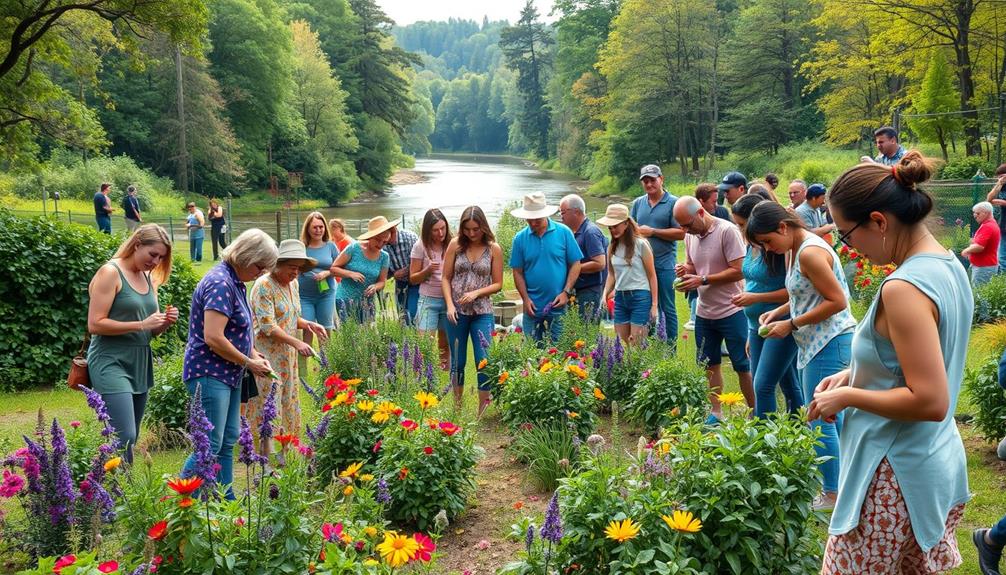
Community engagement strategies play a crucial role in wildlife conservation, ensuring that local needs align with environmental protection goals. When you actively participate in conservation efforts, you help foster a sense of stewardship for local ecosystems, much like how understanding BPD dynamics can enhance interpersonal relationships.
By getting involved in citizen science initiatives, you can contribute valuable data that enhances understanding of local wildlife and their habitats, making a real difference in conservation outcomes.
Advocating for pedestrian access and preserving natural spaces in your neighborhood not only encourages public support for wildlife protection but also benefits community well-being. Join local conservation groups that offer educational opportunities, empowering you and your neighbors to learn about biodiversity and effective conservation strategies.
These programs can deepen your connection to the environment while addressing pressing issues like wildlife crime by involving local populations in protecting their natural resources.
Ultimately, engaging your community in wildlife protection creates a collaborative approach to conservation. Together, you can make informed decisions that not only benefit local ecosystems but also strengthen your community.
Embrace these strategies and watch as your efforts contribute to a healthier environment for both wildlife and residents alike.
Actions Individuals Can Take

Taking action as an individual can make a significant impact on local wildlife and the environment. You have the power to help combat the effects of climate change and support wildlife in your community. Here are three actionable steps you can take:
- Plant native species: By planting native grasses, trees, and shrubs, you can absorb CO2 and create habitats that foster biodiversity.
- Reduce, reuse, recycle: These everyday actions lower your carbon footprint, directly influencing climate change and its impacts on wildlife.
- Volunteer: Get involved with local wildlife refuges or clean-up projects to restore habitats and conserve species threatened by climate-related changes.
Additionally, engaging in citizen science initiatives lets you contribute valuable data to environmental research.
Staying informed about climate change and participating in discussions with your local government empowers you to advocate for policies that protect natural spaces.
Every small action counts, and by taking these steps, you can help mitigate the impacts of climate change on local wildlife. Your involvement not only supports the ecosystem but also inspires others to join the cause.
Frequently Asked Questions
How to Help Wildlife With Climate Change?
You can help wildlife by planting native species, removing invasive plants, and creating pollinator gardens. Participate in local restoration projects and advocate for natural spaces to enhance ecosystem resilience against climate change's impacts.
What Impact Is Climate Change Having on Local Wildlife?
Climate change's impact on local wildlife is profound; rising temperatures and altered habitats force species to adapt or migrate. You'll see mismatched breeding seasons and increased competition, threatening survival for many native plants and animals.
How to Support Local Wildlife?
To support local wildlife, remember: "Many hands make light work." Plant native species, create pollinator gardens, volunteer for clean-ups, use reusable items, and advocate for conservation. Your efforts can truly make a difference in their habitats.
How Can We Solve Climate Change Locally?
You can solve climate change locally by planting native species, participating in community clean-ups, engaging in citizen science, advocating for renewable energy policies, and utilizing resources from organizations like the EPA and NOAA.
Conclusion
As you step outside, imagine vibrant forests teeming with life, where birds sing and butterflies dance in the sunlight. Yet, climate change threatens this delicate balance. By taking small actions, like planting native species or reducing waste, you can help protect these precious ecosystems. Picture a future where children marvel at the beauty of nature, their laughter echoing through lush landscapes. Your efforts today can nurture wildlife and guarantee that the symphony of nature continues for generations to come.
Dana is our Lead Content Writer, bringing a wealth of knowledge and expertise to our team. With a background deeply rooted in animal studies and a profound love for all creatures, Dana is dedicated to crafting engaging and informative content that resonates with our audience. With Dana at the helm, you can trust that our content is accurate and engaging, catering to the diverse interests of animal enthusiasts everywhere.
Animal Facts
Bird Breeding Record Keeping: Tips and Templates
Find out how effective record keeping can transform your bird breeding program and uncover essential tips and templates to enhance your success.

Keeping thorough records in bird breeding isn't just a task; it's the backbone of a successful program. You should track hatching rates, pairings, and any genetic traits. Use colored rings or digital tools like software for accuracy. Regular updates will help you spot patterns and make informed decisions. Templates for hatching records, breeding pairs, and treatment logs can streamline your efforts, making management easier. Don't underestimate the value of online communities for resources and support. By implementing these practices and tips, you'll see improvements in your breeding outcomes, and there's plenty more to explore on effective techniques.
Key Takeaways
- Accurate record keeping enhances breeding strategies by tracking lineage, health issues, and performance history of birds.
- Utilize both traditional methods, like hardbound books, and digital solutions, such as specialized software, for efficient record management.
- Implement identification techniques, including colored rings and unique identifiers, to monitor individual birds and their genetic backgrounds effectively.
- Maintain templates like hatching record charts and breeding pair records to streamline documentation and improve flock management insights.
- Regularly update and review records to analyze breeding outcomes and inform future pairings for better reproductive success.
Importance of Record Keeping
When you keep accurate records of your bird breeding activities, you not only track progress but also enhance your overall breeding strategy. Record keeping is an important part of successful breeding; it allows you to monitor hatching rates, pairings, and lineage effectively.
By maintaining organized records, you can identify genetic traits, health issues, and performance history, which are vital for making informed breeding decisions. Just as in vegan alternatives, where understanding the ingredients plays a key role, thorough documentation guarantees that you have all necessary information at your fingertips.
Documenting bird performance and achievements supports the overall management efficiency of your breeding operations, making it easier to evaluate which pairings yield the best results.
Regular updates and thorough documentation of breeding data lead to improved outcomes while fostering confidence in your ability to advise other breeders. When you keep records consistently, you build a reliable reference that enhances your breeding program.
Observation notes are only valuable when properly documented, emphasizing the need for solid record-keeping methods.
By focusing on this essential aspect of breeding, you not only enhance your own practices but also contribute positively to the broader breeding community.
Effective Record-Keeping Methods

When it comes to record-keeping for your bird breeding program, you've got options—traditional methods like hardbound books or digital tools like Zooeasy.
Utilizing effective goal tracking techniques can enhance your record-keeping process by guaranteeing that your objectives are clear and measurable.
It's essential to implement identification techniques, such as toe punches and pen tags, to track individual birds effectively.
Traditional Vs. Digital Methods
Effective record-keeping methods in bird breeding often boil down to two primary approaches: traditional and digital. Traditional methods, like hardbound books and notebooks, offer reliability and portability, making it easy for you to access breeding details and observations quickly. They're particularly useful for jotting down notes in the field or during breeding sessions. However, they can become cumbersome as your breeding program expands.
Additionally, just as with tracking feline behavior and health, maintaining detailed records is essential for identifying patterns and making informed decisions in your breeding practices. Cat health and nutrition can also be an important aspect to take into account when ensuring the well-being of your birds.
On the other hand, digital options like Zooeasy and Evans Software streamline your record management. These platforms allow you to track lineage, health issues, and breeding outcomes more efficiently, saving you time and reducing the chance of errors. Utilizing colored rings and leg bands for bird identification complements both methods, enhancing tracking accuracy.
You might also find that combining progressive photos with detailed notes can serve as effective tools for visual tracking of your birds' development and traits over time.
Regardless of the method you choose, remember that both traditional and digital systems require regular updates and backups to prevent data loss and maintain consistent record accuracy. Ultimately, the best approach aligns with your preferences and the scale of your breeding program.
Essential Identification Techniques
In the domain of bird breeding, employing vital identification techniques greatly enhances your record-keeping efforts. Using colored rings on your birds can indicate hatch year and breed, making it easier to track and identify individuals within your breeding records. This simple method streamlines your process and guarantees accuracy, much like how understanding BPD can improve relationships.
Implementing leg bands for each bird allows for straightforward monitoring of lineage and breeding history. By assigning unique identifiers, you can easily document each bird's progress and genetic background, which is fundamental for informed breeding decisions.
Additionally, consider using toe punches and numbered pen tags, as they provide reliable identification methods, especially when paired with detailed records. Keeping a combination of photographs and notes further aids in tracking developmental traits and health status over time, giving you a visual reference for breeding evaluations.
Don't forget to regularly update your records with information about individual bird behavior and health. This thorough tracking guarantees effective management of your breeding stock and allows for better decision-making in your breeding program.
Essential Tools and Equipment

To effectively manage your bird breeding program, you'll need essential tools like identification tags and rings.
These items not only help you track individual birds but also simplify your record-keeping process.
Additionally, you may want to incorporate practices from a professional cleaning service, such as having a flexible scheduling option for maintaining a clean environment for your birds.
Consider digital solutions for organizing your data, making it easier to access and update when necessary.
Identification Tags and Rings
Identification tags and rings play an essential role in bird breeding record keeping, providing crucial tools for managing your breeding program.
Colored rings are particularly useful, as they indicate the hatch year and breed information, allowing for quick visual identification of individual birds. This can save you time and effort when monitoring your flock.
Understanding dog health and nutrition can also enhance your overall approach to breeding, ensuring your birds remain healthy and well-cared for.
Leg bands offer a reliable method for tracking and identifying each bird, ensuring your record-keeping remains accurate and organized. For permanent identification, consider using toe punches; they help maintain accurate breeding records over time, even as your birds mature.
You might also find numbered pen tags beneficial; attaching these to birds simplifies tracking and facilitates documentation of breeding pairs and lineage.
By combining various identification methods like rings, leg bands, and photographic records, you'll enhance your ability to monitor bird development and breeding history effectively.
Using these tools won't only streamline your record-keeping process but also improve your overall understanding of your birds' genetics and lineage, helping you make informed decisions in your breeding program.
Digital Record-Keeping Solutions
Keeping accurate records is essential for any bird breeding program, and digital solutions can greatly enhance your efficiency. Specialized software like Zooeasy offers user-friendly interfaces that help you track breeding details, bird health, and lineage without hassle.
By utilizing mobile apps and cloud storage, you can easily access and back up crucial breeding records, ensuring your data is protected and available across various devices. Additionally, it's important to protect your savings by being cautious of scams, much like the need for credibility in bird breeding tools—avoid Gold IRA scams.
Programs like Evans Software streamline data entry, making it easier to document key information such as pairings, hatch rates, and individual bird behavior. This saves you time and reduces the risk of errors in your records.
Additionally, incorporating spreadsheets into your digital management allows for enhanced data analysis. You can visualize trends over time, helping you make informed breeding decisions.
Don't overlook online forums and community groups, either. They can provide valuable insights and recommendations for the best digital tools tailored to your specific breeding needs and challenges.
Breeding Strategies to Document

When planning your bird breeding strategies, it's essential to document key practices that can greatly impact your flock's success. Start by keeping your chickens in pairs or trios, as this enhances breeding management and increases the likelihood of successful pairings.
Make a note of these arrangements, as well as any notable interactions between birds. Additionally, understanding the importance of mental health support can be beneficial, as a calm environment promotes better breeding outcomes.
Regular culling of roosters, ideally at least four times a year, is critical for maintaining a strong genetic line. Document which roosters you've culled and the reasons behind your decisions; this will help you refine your breeding choices over time.
Understanding genetics and traits is equally important; record your observations to make informed decisions about future pairings.
Pay attention to early signs of developmental faults or merits. Documenting these observations allows you to adjust your strategies proactively.
Finally, keep meticulous records of vaccinations and show performances for your breeder birds. This information helps you track their health and performance, ultimately contributing to improved breeding outcomes.
Learning From Breeding Outcomes

To truly capitalize on your bird breeding endeavors, you need to immerse yourself in the outcomes of each breeding cycle. Continuous observation of these outcomes allows you to identify successful traits and faults, helping you make better breeding decisions.
Documenting the performance of your breeding pairs over time is essential; it helps you assess genetic traits and their influence on the quality of your offspring. Incorporating systematic record keeping can streamline this process, making it easier to track yoga for back pain management and identify trends.
Regularly reviewing hatching rates and chick development gives you insights into overall reproductive success and highlights areas needing improvement. You should analyze patterns from past breeding outcomes, as this can inform your strategic pairings and increase the likelihood of desirable traits in future generations.
Utilizing photographs alongside your notes on developmental progress can greatly aid your efforts. Visual tracking of traits allows you to make informed decisions based on historical data, further enhancing your breeding program.
Online Resources for Record Keeping
Utilizing online resources can greatly enhance your bird breeding record keeping. Online forums and communities are gold mines for insights and best practices shared by fellow breeders. You can learn effective strategies and tips that can streamline your record-keeping processes, especially when considering the importance of AI advancements in improving data management practices.
Programs like Zooeasy provide specialized tools designed specifically for tracking poultry and waterfowl records. These platforms guarantee that you have easy access to essential breeding data, making your record keeping more efficient. Additionally, you can find downloadable templates and charts covering various aspects, such as egg production and breeding pair evaluations, which can save you time and effort.
Consider using cloud storage solutions to securely manage and back up your records. This way, you can access your data from multiple devices without the fear of losing it.
Furthermore, extensive articles and guides on avian breeding and management are available online to deepen your knowledge and improve your record-keeping methods. By leveraging these online resources, you'll not only enhance your efficiency but also gain valuable insights that can contribute to the success of your bird breeding endeavors.
Templates for Efficient Tracking
Effective tracking of your bird breeding activities can considerably improve your management practices. By utilizing specific templates, you can streamline your record-keeping and enhance your understanding of your flock.
Here are four important templates you should consider implementing:
- Hatching Record Chart: This helps you systematically track hatch rates, dates, and any issues with poor hatches. It's essential for your reproductive management.
- Breeding Pair Records: Document each breeding pair's hatch rates and types. This aids in evaluating their performance over time and making informed decisions for future pairings.
- Flock Inventory Chart: Keep detailed records of your flock's comings and goings, including sales and purchases. This is significant for managing flock size and composition effectively.
- Treatment Records Log: Document illnesses, treatments, and symptoms for each bird. This facilitates better health management and provides valuable future references.
Frequently Asked Questions
What Is the Best Way to Record Birds?
To record birds effectively, use a mix of hardbound books for reliability and digital software for ease. Incorporate colored rings for identification and document details through notes and photos to track development and traits efficiently.
What Is the Bird Breeding Record App?
The Bird Breeding Record App simplifies tracking your breeding pairs, hatch rates, and lineage. It offers customizable templates, photo uploads, and reminders, making it easier for you to manage your birds efficiently and effectively.
How Profitable Is Bird Breeding?
Bird breeding can be quite profitable, with earnings varying based on species and demand. By managing expenses wisely and enhancing your online presence, you can maximize your sales and attract more customers effectively.
What Are Bird Breeding Codes?
Imagine a librarian organizing books; bird breeding codes serve that purpose for avian enthusiasts. They're alphanumeric identifiers that help you track breeds, traits, and lineage, making your breeding decisions clearer and more informed.
Conclusion
In the vibrant tapestry of bird breeding, your records are the threads that weave success. By keeping meticulous notes, you're not just tracking progress; you're painting a picture of growth and learning. Each entry captures the melody of your efforts, turning challenges into symphonies of knowledge. Embrace these tools and strategies, and watch as your avian family flourishes. Remember, in the dance of life, the more you document, the more beautiful the performance becomes.
Dana is our Lead Content Writer, bringing a wealth of knowledge and expertise to our team. With a background deeply rooted in animal studies and a profound love for all creatures, Dana is dedicated to crafting engaging and informative content that resonates with our audience. With Dana at the helm, you can trust that our content is accurate and engaging, catering to the diverse interests of animal enthusiasts everywhere.
Animal Facts
Squirrel-Friendly Garden Ideas: Coexisting With Backyard Wildlife
Create a vibrant squirrel-friendly garden that delights wildlife, but what clever strategies can you implement to ensure harmony and protect your plants?

To create a squirrel-friendly garden, start by providing alternative food sources like sunflower seeds and unroasted peanuts. This keeps squirrels entertained and distracted from your plants. Use squirrel-resistant bulbs and bury them deep to minimize digging. Employ physical barriers like chicken wire around your beds to protect young plants. You can also use scent-based deterrents, such as blood meal, to keep squirrels at bay. By fostering this coexistence, you enhance biodiversity and enjoy the playful antics of your backyard visitors. There's much more you can do to create a lively and harmonious garden environment.
Key Takeaways
- Create dedicated bird feeders to entertain squirrels and prevent them from damaging your plants while enjoying the wildlife.
- Incorporate squirrel-resistant plants like daffodils and allium to protect your garden while still attracting squirrels.
- Provide alternative food sources, such as sunflower seeds and unroasted peanuts, to redirect squirrels' attention away from your plants.
- Use natural materials and promote healthy plant growth to create a thriving ecosystem that supports both gardens and wildlife.
- Install physical barriers like chicken wire around garden beds to protect young plants while allowing for the presence of playful squirrels.
Coexistence Strategies With Squirrels
Creating a vibrant garden while sharing space with squirrels can be a delightful challenge. To coexist peacefully, you can implement strategies that redirect their attention from your precious plants. Since squirrels consume about a pound of food weekly, providing alternative food sources like sunflower seeds or unroasted peanuts at ground level can keep them occupied.
Additionally, using natural materials in your garden design, such as well-draining soil, can help promote healthy plant growth while minimizing the impact of local wildlife.
Setting up dedicated bird feeders filled with these treats encourages playful behavior, adding a lively atmosphere to your garden. These feeders not only entertain you but also help prevent squirrels from damaging your flowers and vegetables.
You'll find that active year-round feeding creates a buffer against potential harm to your young perennials in the spring as squirrels seek out food sources.
Incorporating trees and shrubs in your garden can further support this coexistence. These natural food sources can offer squirrels a place to forage without interfering with your plants.
Additionally, providing clean water sources like small birdbaths can enhance their experience and promote a harmonious relationship. Observing their antics can make gardening even more enjoyable for everyone, turning potential nuisances into delightful companions in your backyard.
Plant Protection Techniques

Protecting your plants from squirrels requires a blend of strategic choices and practical techniques. Start by selecting bulbs that squirrels tend to avoid, such as daffodils, allium, and fritillaries. These can be planted alongside more vulnerable options like tulips.
When planting, make sure to bury your bulbs deep in the soil. This not only makes it harder for squirrels to dig them up but also encourages healthy growth. Additionally, incorporating natural materials like stone and wood in your garden can create an inviting atmosphere that attracts other wildlife, which can help to deter squirrels from your plants elements for farmhouse dining room style.
Another effective method is to use chicken wire to cover newly planted bulbs. This allows your plants to thrive while deterring squirrels from accessing them.
Additionally, pay attention to seasonal patterns; choosing the right planting time can greatly influence squirrel activity in your garden.
Regularly remove any bulb debris, as this minimizes the attraction for squirrels searching for food. By creating a garden environment that also attracts birds and other wildlife, you'll enhance the ecosystem around your trees and plants, further discouraging squirrels.
With these techniques, you can enjoy a flourishing garden while coexisting peacefully with your backyard wildlife.
Scent-Based Deterrents

Scent-based deterrents can be an effective way to keep squirrels away from your garden. By utilizing strong odors, you can disrupt their foraging behavior and encourage a more harmonious coexistence.
Here are three scent-based deterrents you can try:
- Chicken Manure Pellets: The smell of chicken manure pellets is known to repel squirrels, making them a great addition to your garden.
- Blood Meal: This product emits a strong scent that can deter squirrels and help protect your valuable plants from their nibbling.
- Coyote Urine or Dog Urine: These natural repellents play on squirrels' territorial instincts, making them think predators are nearby, which can keep them at bay.
Physical Barriers for Protection

When it comes to safeguarding your garden from pesky squirrels, employing physical barriers can be a game changer. You can start by installing baffles on your bird feeder. These devices create a physical barrier that prevents squirrels from accessing the food, allowing birds to feed without competition.
If you want to go further, consider constructing metal cages around your feeders to limit those squirrel raids and protect your birdseed from being stolen. Additionally, using tough dog names can serve as a fun reminder of your furry friends while you work in your garden.
For your garden beds, strategically placing barriers like chicken wire can protect young plants and bulbs from being dug up or eaten. Covering newly planted bulbs with wire not only protects them during growth but also allows air and moisture to reach the plants while deterring squirrels.
Remember, squirrels need to find food and nesting sites, so being proactive with these barriers can greatly minimize wildlife activity in your garden.
Regularly checking and maintaining these physical barriers is essential to guarantee their effectiveness. By staying vigilant, you can create a protective shield around your garden, allowing you to enjoy its beauty while coexisting with nature.
Benefits of Squirrel-Friendly Gardens

Creating a squirrel-friendly garden not only helps mitigate the challenges posed by these agile critters but also brings a host of benefits to your outdoor space. By designing your garden with squirrels in mind, you can enhance biodiversity and create a thriving ecosystem.
Engaging in family activities that promote creativity, such as gardening, can also encourage children to develop a deeper appreciation for nature and wildlife family activities that promote creativity.
- Improved Biodiversity: Attracting various species supports a balanced ecosystem. Different animals contribute to the health and stability of your garden.
- Natural Food Sources: Providing squirrels with nuts, seeds, and fruits guarantees they've the nourishment they need. This, in turn, encourages other wildlife to visit, enriching your garden's habitat.
- Pest Control: Squirrels serve as natural pest controllers, munching on insects and helping maintain a healthy garden. Their presence can reduce the need for chemical pesticides.
In addition to these benefits, incorporating squirrel-friendly elements like feeders and nesting boxes creates an enjoyable environment for both you and the critters.
Watching playful squirrels can improve the aesthetics of your outdoor space and entertain your family. By embracing a squirrel-friendly approach, you're fostering a lively, diverse, and sustainable garden.
Frequently Asked Questions
How to Coexist With Squirrels?
To coexist with squirrels, you can create feeding stations, use barriers to protect plants, and implement scent deterrents. Encouraging natural habitats and limiting competition for food helps maintain harmony between you and these playful animals.
How Do I Make My Backyard Squirrel Friendly?
To make your backyard squirrel-friendly, set up feeders with sunflower seeds, plant non-preferred bulbs, and create brush piles for shelter. Deep planting and using chicken wire can help protect your favorite plants from squirrels.
What Plants Do Squirrels Hate the Most?
Think of your garden as a fortress. To keep squirrels at bay, plant daffodils, allium, and marigolds. Incorporating strong herbs like rosemary and bitter foliage can also make your garden unappealing to these critters.
How to Live in Harmony With Squirrels?
To live in harmony with squirrels, provide alternative food sources, install dedicated feeders, and use scent deterrents. Plant non-preferred bulbs, and enjoy observing their antics—this fosters a balanced relationship with these playful creatures.
Conclusion
By embracing squirrel-friendly garden ideas, you not only create a thriving habitat but also enjoy the company of these playful critters. Did you know that a single squirrel can bury up to 25 acorns in a day? Imagine the joy of watching them scurry around, hiding their treasures! With the right coexistence strategies, you can protect your plants while fostering a lively ecosystem in your backyard. It's a win-win for both you and your furry neighbors!
Dana is our Lead Content Writer, bringing a wealth of knowledge and expertise to our team. With a background deeply rooted in animal studies and a profound love for all creatures, Dana is dedicated to crafting engaging and informative content that resonates with our audience. With Dana at the helm, you can trust that our content is accurate and engaging, catering to the diverse interests of animal enthusiasts everywhere.
-

 Vetted6 months ago
Vetted6 months ago15 Best Dog Food Brands Recommended by Vets for Healthy and Happy Pups
-

 Vetted6 months ago
Vetted6 months ago15 Best Affordable Dog Foods That Won't Break the Bank
-

 Vetted6 months ago
Vetted6 months ago14 Best Homemade Dog Food Recipes Your Pup Will Love – Vet Approved & Nutritious
-

 Cats5 months ago
Cats5 months agoCat Weight Chart by Age: Kitten to Senior in Lbs
-

 Vetted6 months ago
Vetted6 months ago15 Best Cat Foods for Managing Hyperthyroidism – Vet Approved and Feline Friendly
-

 Vetted6 months ago
Vetted6 months ago15 Best Dog Foods for Kidney Disease – Expert Recommendations for Your Pet's Health
-

 Vetted5 months ago
Vetted5 months ago15 Best Affordable Cat Foods That Won't Break the Bank
-

 Vetted6 months ago
Vetted6 months ago15 Best Vet-Recommended Dry Cat Foods for Indoor Cats – Keep Your Feline Friend Happy and Healthy

































